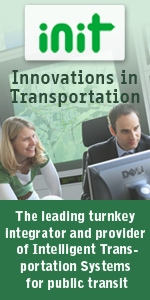

| In This Issue |
| » NEWS HEADLINES |
| » COVERAGE OF THE 2010 APTA RAIL CONFERENCE |
| » COMMENTARY |
| » PEOPLE ON THE MOVE |

The classifieds in this issue offer employment at transit and government agencies throughout North America!
| COVERAGE OF THE 2010 APTA RAIL CONFERENCE |
Price: North American Cities Use Old Streetcar Grids for Newfound Livability
BY JOHN R. BELL, Program Manager-Communications
Gordon Price, director of the city program at Simon Fraser University in Vancouver, BC, told a rapt audience June 7 at the  APTA Rail Conference about how cities have gone from pursuing “Motordom” to expanding public transportation—and increasing their livability and vitality in the process.
APTA Rail Conference about how cities have gone from pursuing “Motordom” to expanding public transportation—and increasing their livability and vitality in the process.
Price, a six-term Vancouver city councilor, spoke as part of a luncheon webcast seminar sponsored by APTA business member HNTB.
In the 19th and early 20th centuries, he said, the streets of almost all large North American cities were a controlled chaos in which streetcars wove among pedestrians, cyclists, and drivers of early automobiles—“a kind of ballet of the street,” Price said. “I think what would have amazed us most is what we would consider a kind of anarchy” in the way people used the street.
Although many cities abandoned the walkable, streetcar-oriented infrastructure in the 1950s, many cities retain the streetcar-based grid and neighborhood design—enough to make the creation of modern transit-oriented development eminently workable, Price said.
But between those early streetcar years and now, cities went full tilt toward one goal: making automobile traffic flow as fast as possible, no matter the cost to walkability, street life, or neighborhood charm—toward “Motordom.” While Peter Norton used this term most recently in Fighting Traffic: The Dawn of the Motor Age in the American City, it dates back to 1920s newspaper articles about automobile clubs.
“What Motordom achieved was the social reconsideration of the street,” Price explained. This way of thinking began with an appeal to public safety—to prevent the deaths of children run over while playing in the street. By the end of the 1920s, streets had become dominated by cars.
Price cited 1942—when the Institute of Transportation Engineers released its first-ever Transportation Planning Handbook—as the dawn of the Age of Motordom. “These are very, very powerful books. They represent the standards that will be used to design the postwar world,” he explained. The handbook held “the efficient, free, and rapid flow of traffic” as the ultimate aim of transportation planning.
The blind pursuit of Motordom was based on a collection of principles that were little questioned at the time, according to Price, such as believing gasoline to be an infinite resource and placing the end to congestion at some point always in the future.
Chief among these principles was to make parking an integral, paramount concern in urban planning, leading to the demolition of historic buildings and streetscapes in many downtown areas in the U.S. and Canada to make way for surface parking lots. “Form follows parking,” Price said. “The rest is detail—and not all that significant detail.”
Vancouver ultimately defeated Motordom, Price said, by “failing” to build what many residents and civic leaders supported in the 1950s and 1960s: highways leading into downtown. Because those freeways never came, the city remains a network of streetcar villages, he explained.
Public transportation continues to thrive in Vancouver and its neighborhoods, he said: almost all residents have access to transit and transfers among the many modes are seamless. This development has enabled has allowed Vancouver to double its downtown population in 10 years while seeing its traffic congestion decline and number of walking trips increase in the same period.
Price noted that other cities in the U.S. and Canada can boast similar achievements—thanks to the streetcar planners of today and yesterday.
Yet oddly, Motordom played a role in the public’s demand for public transportation. “Congestion is our friend,” Price said. And in some localities “it’s the only form of road pricing that is politically possible.”
| « Previous Article | Return to Top | Return to Main | Next Article » |
|
||||||
| AMERICAN PUBLIC TRANSPORTATION ASSOCIATION |
Telephone (202) 496-4800 • Fax (202) 496-4321
Search Back Issues
